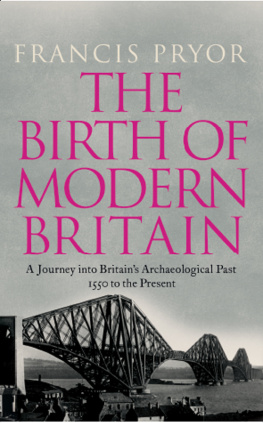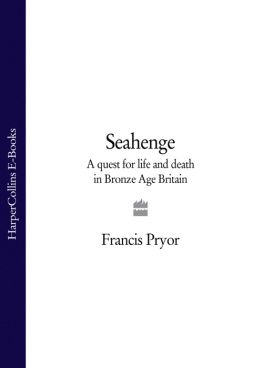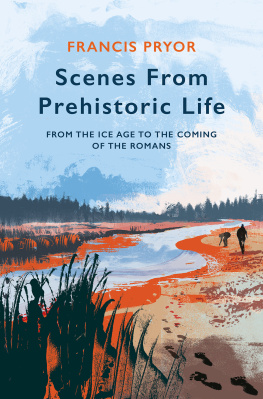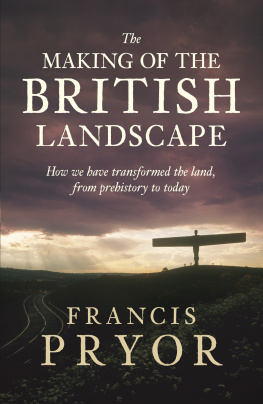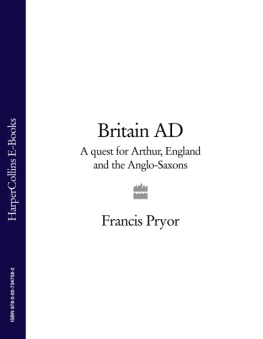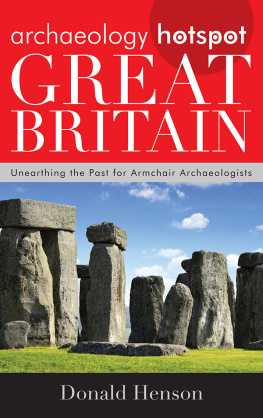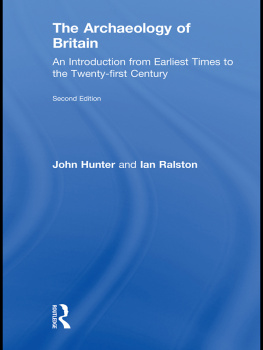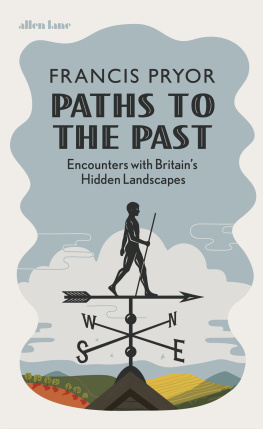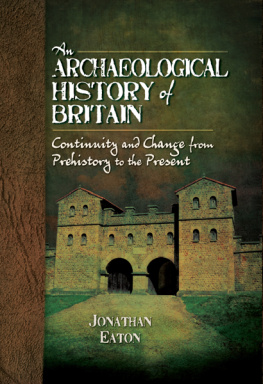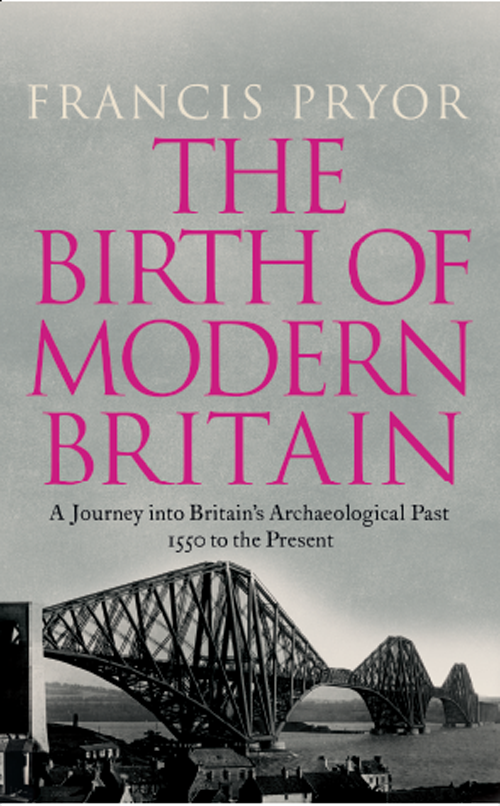
Contents
For my step-mother, Barbara Jean Pryor, for her quiet support and encouragement.
Unless otherwise stated, all photographs are Francis Pryor
Model farm, Holkham Park, Norfolk
A view across the lake towards the Pantheon (1754) at Stourhead, Wiltshire
The restored grotto at Painshill, Surrey
A view along the first turnpike road (1663) in the village of Caxton, Cambridgeshire
The cast-iron Waterloo Bridge which carries the great Holyhead Road across the Afon Conwy at Betws-y-Coed
A paired toll house and weighbridge house on either side of the A5 at Ty Isaf
Milestone No. 73
Sunburst gates at the southern end of the Menai Strait suspension bridge
The brickwork faade of the southern entrance to the Blisworth Tunnel, Northamptonshire
A view along the bed of the tramway that led from the valley up to the navvy camp on Risehill, North Yorkshire
Grooves left by drill-holes to pack an explosive charge
Bridge over the A43, where it is crossed by the M1 at Junction 15, near Northampton
The River Porter in Whitely Woods, Sheffield
York Gate
The Paragon
A view of the Forth Rail Bridge
A view of housing in Swindon, Wiltshire
A tipping-cistern toilet block at Hungate, York
The basement floor of so-called cellar houses
The Stanley Mills, near Perth, from the River Tay
Terrace housing at Caithness Row, New Lanark
New Buildings tenement block
A view of a lead mine by William Ridley of Allenheads
A view along the Washing Rakes at the North of England Lead Mining Museum, at Killhope, Co. Durham
The potbank at the Gladstone Potterys Roslyn Works, Longton
Albert Dock, Liverpool (authors photograph by permission of the Gladstone Pottery Museum)
The recently restored Swiss Bridge in Birkenhead Park, Merseyside
Hamilton Square, Birkenhead, Merseyside
The 768th (2006) Corby Glen Annual Sheep Fair, in the southern Lincolnshire Wolds, near Bourne
The chancel of St Marys Church, Bottesford, Leicestershire
The church of St John the Evangelist at Little Gidding, near Peterborough
The gravestone of Elizabeth Cuthbert (d. 1685) in the south nave aisle of St Magnus Cathedral, Kirkwall, Orkney
The Sight of Eternal Life Church, Shrubland Road, Hackney, east London
The Union Workhouse, Gressenhall, near East Dereham, Norfolk
Bridge designed by Robert Adam, built by General George Wade in 1733 across the upper reaches of the Tay, at Aberfeldy (Perth and Kinross)
The Second World War defensive landscape of the southern Wash at Lawyers Creek, near Holbeach St Matthew, Lincolnshire
Ruck machine-gun post
The Carmarthen stop line
A view of the Carmarthen stop line from a gun emplacement overlooking the mouth of the River Tywi at St Ishmael, near Kidwelly
Excavation of a series of Second World War defensive works at Shooters Hill, south-east London
Three maps of Shapwick, Somerset. From Gerrard and Aston, The Shapwick Project. Somerset. A Rural Landscape Explored (2007). With kind permission of Professor Chris Gerrard.
Map showing the farming regions of early modern England (15001750). From Thirsk, Englands Agricultural Regions and Agrarian History,15001750(1987)
Survey of the Buckinghamshire village of Akeley, based on an enclosure map of 1794. From Jones and Page, Medieval Villages in an English Landscape (2006)
Farm buildings from a design by J. B. Denton of 1879. From the Royal Commission on Historical Monuments 1997, p. 153
Map showing the distribution of landscape parks in East Anglia in the late eighteenth century. From Tom Williamson, Designed Landscapes: The Regional Dimension, Landscapes, Vol. 5, No. 2, p. 18 (2004). With kind permission of Professor Tom Williamson.
Two idealised plans showing the layout of typical model or estate farms in England around 17501800 and 18001840. From Wade Martins, The English Model Farm (2002), fig. 1
Two idealised plans showing the layout of typical model or estate farms in England around 18401860 and 18601900. From Wade Martins, The English Model Farm (2002), fig. 1
General plan of Aston Hall, Birmingham. From Post-Medieval Archaeology, Vol. 42, Pt 1, p. 103 (2008)
Map showing the location of eighty-one planned villages erected between c. 1730 and 1855 in south-west Scotland (Dumfries and Galloway). From Philip, Landscapes, Vol. 6, No. 1, p. 89 (2005)
Map of the drove roads of Scotland. From Haldane, The Drove Roads of Scotland (2008)
The principal long-distance routes in England and Wales in the seventeenth century, prior to the turnpikes. From Wright, Turnpike Roads (1992)
Map of the Grand Union (earlier the Grand Junction) Canal in Northamptonshire
Excavated traces of wooden railway (or waggonway) lines. Illustration reproduced courtesy of Wrexham County Borough Council.
Map showing the thirty-five major historic towns and cities of England. From Thomas, Mapping the Towns, Landscapes, Vol. 7, No. 1 (2006), p. 73
Map showing how space within London was organised around 1750. From Short, The South-East, p. 175
Plan of the archaeological evidence for the Rose theatre. From Current Archaeology, No. 124, p. 186
Excavations at Wednesbury Forge, West Midlands. From Belford, British Archaeology, No. 107, p. 33
The Upper Forge at Coalbrookdale, Shropshire. From Belford, British Archaeology, No. 107, p. 34
Exterior view of a Manchester cellar house in Victorian times. From Miller and Wild, A & G Murray and the Cotton Mills of Ancoats, p. 31 (2007)
Flow diagram illustrating the production of cotton textiles. From Miller and Wild, A & G Murray and the Cotton Mills of Ancoats, p. 162 (2007)
Plan showing the organisation of the industrial landscape around the entrance to the Park Level Lead Mine at Killhope, Co. Durham. From Forbes, Lead and Life at Killhope (1987), p. 19
Map showing the development of urban areas (black) and Wombwell Wood (stippled) in the town of Wombwell, South Yorkshire. From Hey and Rodwell, Wombwell, Landscapes, Vol. 7, No. 2 (2006), p. 25
Drawing of the constructional details of the traditional hovel type of updraught bottle kiln. From Post-Med. Arch., Vol. 42, Pt 1, p. 205 (2008)
Plan of the purpose-built grounds surrounding the Quaker asylum at Brislington House, Bristol. From Rutherford, Landscapes, Vol. 5, No. 2 (2004), p. 30
Outline drawing of a later nineteenth century triangular blue cotton neckerchief. From Oleksy, Post-Med. Arch., Vol. 42, Pt 2, p. 293
Hand-carved model boat found in a large void beneath Court 3, Parliament House, Edinburgh. From Oleksy, Post-Med. Arch., Vol. 42, Pt 2, p. 296 (2008)
Map of Harwich Basin in the early eighteenth century. From Post-Med. Arch., Vol. 42, Pt 2, p. 232
The defensive landscape at Landguard Fort, near Harwich, Suffolk. From Meredith, Post-Med. Arch., Vol. 42, Pt 2, p. 235 (2008)
A composite plan, based on contemporary sources showing the main areas of activity at the Norman Cross (Peterborough) Depot, or prisoner-of-war camp
While every effort has been made to trace the owners of copyright material reproduced herein, the publishers would like to apologise for any omissions and would be pleased to incorporate missing acknowledgements in future editions.
F ROM THE MOMENT I began this four-volume archaeological history of Britain I knew that, when I ventured outside my own field of expertise in later prehistory, I would have to rely on the cooperation and goodwill of many colleagues. But instead of encountering silence or, worse, resentment, I was astonished by the way medievalist scholars took me under their wing and made the task of writing
Next page
